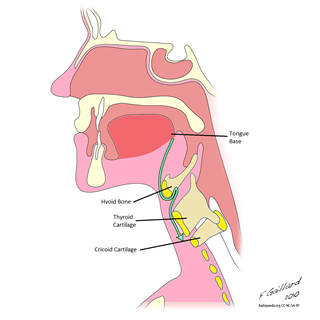I thought I best expand on what a Thyrogloassal Duct Cyst actually is, as there is a lot of medical jargon out there if anyone decides to Google it.
It’s something I had never heard of before it was mentioned to me by my G.P. and consultant after my first few tests. A Thyroglossal Duct Cyst is a congenital cyst, which develops between 5-8 weeks of gestation. I have been asking mum what the hell she was drinking at Christmas in 1993.
Anyhow, during this stage of development, the thyroid moves to the place it will permanently stay (above what will later develop as the collar bone). However, in some cases the tube does not fully reach the final place it should, meaning it often runs from the back of the tongue dow to the thyroid, and forms a pocket, or a ‘duct’. It is when this duct gets infected, or grows, or becomes filled with fluid, that it becomes noticeable, often through a lump appearing on the outside of the neck or in some cases due to it pressing on the windpipe.
Thyroglossal Duct Cysts are thought to be present in 7% of the population, and accounts for 2% of neck masses in adults. They usually become apparent during childhood, but in some cases, like mine, they don’t become apparent until adulthood. In 1 in every 100 cases, Thyroglossal Duct Cysts are cancerous, which is why I was referred and seen by specialists so quickly, particularly as ectopic thyroid tissue was suspected inside the cyst (tissue where it shouldn’t have been). Biopsies are the norm during diagnosis, but as in my case, many biopsies are inconclusive and cancerous cells cannot be distinguished, meaning the cyst is removed anyway.
As mentioned in another blog post, I put my cyst down to being under the weather and my glands becoming sore and swollen. I now realise this wasn’t the case at all. The cyst was a distinctive, hard, ball located right at the front of my neck.
During my diagnosis, there was a common misconception that the type of cyst I had was nothing to worry about, and that it was a small lump on the surface of my skin that would only need to be removed for cosmetic reasons. Even my dad said it would be something to do with the stress of starting a new job and my busy lifestyle. I don’t quite think some people understood how concerned I was about it, and that it’s removal wasn’t as simple as extracting a superficial lump just below the skin. I know many people probably said this to just make me feel better, even though inside I was really quite scared.
My mum was actually the person who I felt was the most supportive. Of course it was unlikely to be cancer, but I wanted to talk about it, and look at the options if it was a ‘worse case scenario’. My Nana was also very supportive. She was diagnosed with cancer in March this year, and also had cancer in her jaw in childhood. She knew how I felt, and that the uncertainty was the worst part, and actually, being repeatedly told ‘it will be fine’ is not always the most constructive answer that you want to hear.

In fact, the surgery I would need to remove it, and any possibility of cancer was a two hour procedure, taking out not only the cyst, but surrounding tissue and part of my hyoid bone (the bone connected the my tongue). This is know as the Sistrunk Procedure.
I didn’t have to have the procedure done, but can you imagine thinking for the rest of your life’what if?’.